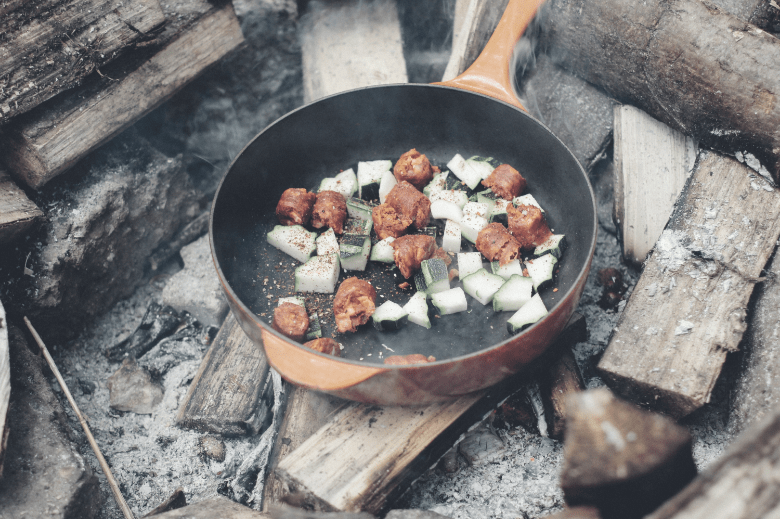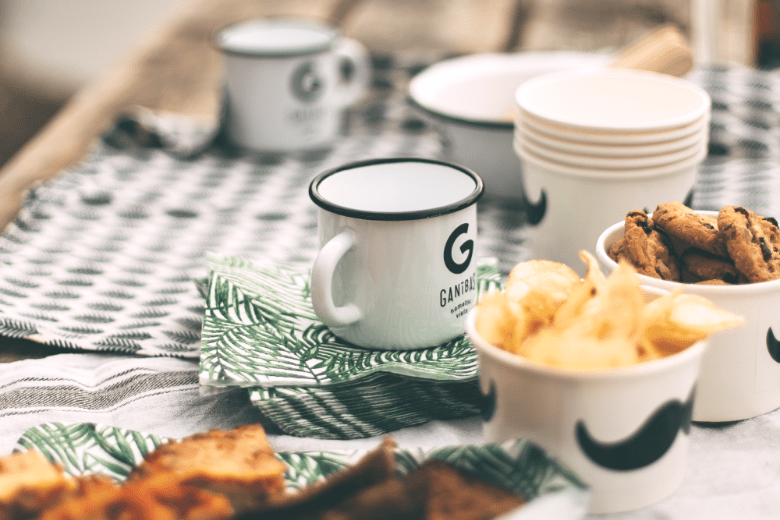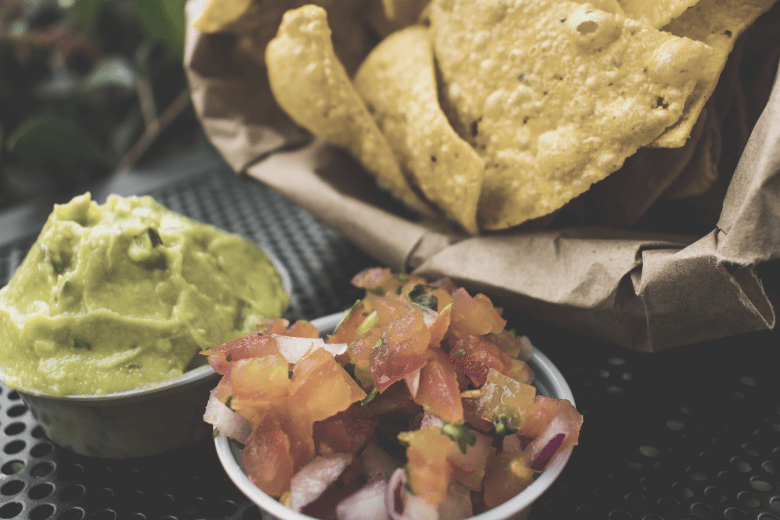Maybe you think that cooking breakfast over an open fire is overly romantic and a far cry from reality. The truth is that you can enjoy yummy camping food with a little planning along with the right tools for the job.
And it’s not rocket science either. The essential thing to remember is to keep it simple and remain flexible. My 20 plus years of camping experience has taught me a thing or two.
Tips for Getting It Right
There are several things you can do before, during, and after your trip to make it more pleasant—and tasty. I’ll go over a few helpful suggestions along with some added info about making your outdoor dining experience more enjoyable.
Before You Leave Home
The crucial thing you need to do first is to scope out the lay of the land. That means finding out what the cooking situation is. Is there a fire pit at your site? If not, do you have a grill? I hate to be the pessimistic one but also check into the availability of a shelter in case it rains.
I like to use my gear. I’ll bring a camp stove or a portable hibachi. I know how it handles and what to expect. Besides, it means no worries about starting and maintaining a campfire. I save that for the marshmallows after dinner.
Planning Your Menu
The next thing to do is to figure out what you’re going to make and eat. Easy camp food isn’t just bacon and eggs in the morning—though I usually cook it at least once per trip. The keyword is quick.
Simple dishes like hamburgers, steaks, or brats are ideal for campsite dining. If you like fishing, it offers another option for the freshest possible catch ever. And don’t forget your girl scout or boy scout days.
Nothing beats wrapping up a meal in aluminum foil and cooking it over hot coals.
It’s essential to be realistic. Leave some room for flexibility to find some tasty local fare or treat yourself to a restaurant dinner.
When I scout out somewhere to eat, I look for the local place and order the house specialty.
Packing Your Camp Kitchen
This part is crucial to having good camping meals. My advice is to think about everything you’ll need to prepare each meal you plan to cook from the pot to the spices.
I like to measure out any ingredients and put them in small snack bags that I label. You can think of it as planning your mis en place before you leave. Don’t forget the utensils you’ll need too.
I put everything into a plastic bin that I label as the “Kitchen.”
Remember to pack the extras you’ll need such as salt, pepper, aluminum foil, paper towels, and Ziploc bags. Toss in a few plastic bags and a garbage bag or two for the trash and recyclables.
During the Trip
Eating alfresco presents some challenges that you don’t have in the comfort of your kitchen. Make sure to know what you can expect so that you can prepare for it. Let’s discuss a few everyday things.
Critters
Camping means wildlife. Raccoons, bears, and the like are opportunistic and resourceful animals. Your cooking will tempt them too. To avoid nocturnal visitors, obey the best practices of camping. They include:
- Keep a clean campsite.
- Toss out the trash every night before bed.
- Store food and your kitchen container in your car or the camper if you have an RV.
- Cook and wash dishes away from your site, if possible.
Remember that they are cheeky and bold sometimes and may wander into your site even if you’re there.
Food Temperature
One of my pet peeves is cold meals. One way to avoid them is to set up your campfire and grill with a hot and cooler side without charcoal. The ambient warmth is enough to keep your food at the correct temperature. If you’re cooking for a crowd over a small fire, it’s essential.
Cold is another challenge. The problem exists because of foodborne illnesses. The Centers for Disease Control and Prevention put the number of affected Americans at 48 million per year which is probably a conservative figure.
Restaurants have the health department to make sure they follow the codes. Your kitchen lacks this oversight. Play it smart and err on the side of caution.
Different foods have safe minimum temperatures. The 40 to 140℉ is the tricky range where foodstuffs are vulnerable to disease-causing microbes. If you’re not sure, check it.
You might even consider picking up some dry ice for your cooler. It’ll get colder and last longer. You will need to be careful when handling it though.
Bugs and Mosquitoes, Oh, My!
No matter what type of camping you do, I’d recommend investing in a screen tent. Believe me. Flies like charcoal-broiled burgers as much as you. Besides, you want to enjoy your food, don’t you?
Sure, you can use a bug spray, but the taste floating in the air is a major buzzkill, methinks.
If anything, it’ll help keep foods cooler by shielding them from sunlight. You’ll get a lot of use out of it. Trust me. You’ll enjoy your morning cup of joe and campfire breakfast that much more without gnats swarming around you.
Clean-Up
Washing up after cooking often is as much of a hassle as cooking on a tiny grill. A couple of things will help with this chore.
First, wipe dish soap on the bottom of any pots and pans going over an open fire. You only have to clean the soot off of them once to get it. It is a hateful task—and messy too!
Use a product that is eco-friendly. Remember that an entire campground of people are doing the same thing and spilling it down the same drains.
Second, put a pot of water on the fire as you eat. Most sites have a cold water tap. You have to provide the hot. By the time you finish, you’ll have hot water to make your job easier.
Finally, take care about where you dump your gray water. Don’t toss it in the brush. It’ll attract wildlife and may kill the plants too if it’s hot.
Tips for Making Meals Easier
It pays to think out of the box when it comes to making life simpler at the campsite. Instead of bringing a dozen eggs with you, crack what you’ll need into a water bottle. Think instant scrambled eggs.
And don’t forget the possibilities of one-pot meals. They are the bee’s knees for a quick and tasty meal. Who says you can’t have a gourmet-caliber dinner such as orange-glazed stuffed pork chops with buttermilk biscuits?
You can use the same hack with mason jars to make delicious salads. The best part is that clean-up is minimal with a one-dish lunch. And make-ahead meals like overnight oats or Panzanella are perfect when you want something without a lot of fuss.
Let’s talk about some other yummy possibilities for camping food that will surely get you hungry.
Breakfast Foods
Breakfast is probably the easiest meal on the menu. Remember that bottle of eggs you packed? Pour out what you need and add some cheese. You can fry up some veggies in butter or vegetable oil to make an omelet or frittata for a real treat with that bacon or sausage you brought.
I’m not as much of a fan of sweet foods for breakfast, but don’t let me stop you. You can use that Dutch oven as, well, an oven to make blueberry muffins or an apple cobbler. The best thing is that you won’t heat up the house either.
Lunches
Sandwiches are a safe bet and quick to make. And unless you’re camping in a remote area, the chances are there is a grocery store nearby. If you want something hot, try using a pie iron. This utensil is a hinged metal rectangle or square that holds the sandwich which you can heat over a fire.
They’re easy to use even for children, or perhaps, especially to keep them occupied. You can the same thing with that handy aluminum foil you packed. I’d recommend that you get the heavy-duty stuff since you’ll likely be handling foods more.
I’d be remiss if I failed to mention the king of camping food, hot dogs. They cook up in a snap and, again, give the kids participate in camp chores. All you need is some potato chips and a pint of coleslaw from the corner market.
Dinners
I love making dinner at the campsite. There’s an unmistakable romance about it. Think of a lovely tilapia filet dotted with butter and fresh herbs, cooked in aluminum foil. Add a glass of wine, and you have the makings of a five-star meal. Go ahead and bust out the cloth napkins too!
It’s not hard to take camping food to the gourmet level with other simple additions. A steak topped with a herb-infused compound butter is this side of heaven. You can even make it ahead of time. As it melts, it’ll create a divine sauce.
Kabobs are another excellent choice that works well by the campfire. You can make a shish kabob bar and let everyone make their own with chicken, pork, or beef you marinated earlier in the day.
And who doesn’t love baked potatoes? Wrap them in tin foil and nestle them in the coals. The smoke will infuse them with its yummy richness. And that’s something you can’t get at a restaurant.
Speaking of which, take advantage of it in other ways too. You can soak wood chips and or even fresh herbs to add a flavor boost to that grilled chicken breast.
If you are cooking over a campfire, make sure to check on what kind of wood you can use. Some states have restrictions on supplies from out of state because of pest infestations. You’ll likely see a sign at the park entrance warning you about it if it’s an issue.
Snacks
I’m a huge fan of bentos. It’s a different riff on the packed lunch. Instead of a bag or lunch box, you put your meal in a plastic square container with smaller ones and dividers to keep everything separate. It’s an excellent option for a meal on the trail.
You can fill it with a variety of foods including cheese, fruits, and nuts along with any prepared items you want to add. It’s a lot cheaper than buying the packaged ones at the grocery store.
Fresh or Packaged? That Is the Question.
I prefer fresh snacks and foods as opposed to those wretched packaged-just-add-hot-water meals. Call me a cynic, but I like the texture and taste of produce and meat better than dehydrated mystery dishes.
For one, they’re not cheap. And if you have special dietary needs, you may have some problems finding selections you like.
And imagine your disappointment at thinking you’re getting a wonderful lasagna meal only to discover that you can’t stomach it at all. Besides, isn’t hanging out around your campsite part of the whole experience anyway?
That said, you can keep some staples around, just in case. Macaroni and cheese, Boston baked beans, and, of course, hot dogs, are failsafe.
Remember what I said about scoping out the campground before your trip? The same advice applies to the camp store and nearby town. See what your options are for finding groceries.
I’d also suggest sticking with foods with a longer shelf life. Iceberg lettuce, apples, potatoes, and onions will last the entire time and provide the basis for many a good meal.
Final Thoughts
Camping food adds to the delightful experience of spending time outdoors in Nature. The underlying theme is quick and easy, and you won’t sacrifice taste. In fact, you’ll learn some cooking techniques that you can take home to your kitchen.
The key is to prepare both your menu and your packing. These simple measures can make your trip more carefree and enjoyable. And it’s not a whole lot different from what you do know. It’s just the setting that’s changed.



